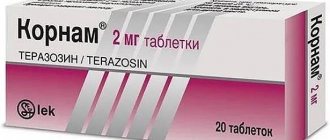Composition and release form
| Controlled-release film-coated tablets | 1 table |
| active substance: | |
| tamsulosin hydrochloride | 0.4 mg |
| excipients: macrogol 8000 - 40 mg; macrogol 7000000 - 200 mg; magnesium stearate - 1.2 mg | |
| shell: Opadry yellow 03F22733 (hypromellose - 69.536%, macrogol 8000 - 13.024%, iron dye yellow oxide - 17.44%) |
10 pcs in a blister made of PVC foil and aluminum foil laminated; in a cardboard pack 1 or 3 blisters.
Price
There is a price difference between the drugs. Tablets with the Okas prefix are significantly more expensive than just Omnic. The table demonstrates this difference well.
| A drug | Price |
| Omnic capsules 0.4 mg No. 10 | 380 rub. |
| -//- № 30 | 800 rub. |
| -//- № 100 | 2300 rub. |
| Omnic okas tablets 0.4 mg No. 10 | 600 rub. |
| -//- № 30 | 1600 rub. |
Despite the general principle of action, tamsulosin tablets and capsules have some differences. The difference is that, unlike capsules, Omnic Ocas has a controlled release of the active substance. This makes it an order of magnitude higher and better than capsules, since it ensures an almost constant concentration of the active substance throughout the day.
The second important difference is that the side effects are more pronounced with capsules than with tablets. Accordingly, the latter are better tolerated.
The last significant difference is cost. Of course, this fact does not add any advantages to the tablets and they are no better in this regard, but it should be remembered. Once it becomes clear what the difference is between two almost identical medications, making a choice in one direction or another becomes easier.
Pharmacodynamics
Tamsulosin is a specific competitive blocker of postsynaptic α1-adrenergic receptors, especially the α1A and α1D subtypes, which are responsible for relaxing the smooth muscles of the prostate gland, bladder neck and prostatic urethra. Omnic Okas at a dosage of 0.4 mg increases the maximum speed of urination, and also reduces the tone of the smooth muscles of the prostate gland and urethra, improving the outflow of urine, etc. reducing the severity of bowel movements. Omnic Okas also reduces the severity of filling symptoms, in the development of which detrusor overactivity plays an important role.
With long-term therapy, the effect on the severity of filling and emptying symptoms is maintained, reducing the risk of developing acute urinary retention and the need for surgical intervention.
α1A-adrenergic blockers may lower blood pressure by reducing peripheral resistance. When using the drug Omnic Okas in a daily dose of 0.4 mg, no cases of clinically significant decrease in blood pressure were observed.
Pharmacokinetics
Suction. Omnic Ocas is a matrix-based controlled release tablet using a non-ionic gel. This dosage form provides a long and slow release of tamsulosin and sufficient exposure with slight fluctuations in tamsulosin plasma concentrations over 24 hours.
Tamsulosin in the form of Omnic Okas tablets is absorbed in the intestines. Absorption is estimated at 57% of the administered dose. Eating does not affect the absorption of the drug. Tamsulosin is characterized by linear pharmacokinetics. After a single oral administration of Omnic Ocas tablets on an empty stomach, the Cmax of tamsulosin in plasma is achieved on average after 6 hours. In the equilibrium state, which is achieved by the 4th day of administration, the concentration of tamsulosin in plasma reaches its highest value after 4–6 hours both on an empty stomach and after eating. Cmax in plasma increases from approximately 6 ng/ml after the first dose to 11 ng/ml at steady state. The lowest plasma concentration of tamsulosin is 40% of the maximum fasting and postprandial plasma concentration. There is significant individual variation among patients in plasma concentrations of the drug after a single dose and multiple doses.
Distribution. Plasma protein binding is about 99%, Vd is small (about 0.2 l/kg).
Metabolism. Tamsulosin is slowly metabolized in the liver to form less active metabolites. Most of tamsulosin is present in the blood plasma in unchanged form. The ability of tamsulosin to induce the activity of microsomal liver enzymes is practically absent (experimental data).
In case of liver failure, no dosage adjustment is required.
Excretion. Tamsulosin and its metabolites are primarily excreted in the urine, with approximately 4–6% of the drug excreted unchanged.
T1/2 of tamsulosin in the form of Omnic Okas tablets with a single dose and at steady state is 19 and 15 hours, respectively.
Method of use
In tablets and capsules, the dosage of the active ingredient tamsulosin is 400 mcg. It is recommended to take one capsule once a day. It is preferable to drink it in the morning, after meals.
Okas tablets are also taken once. However, in this case there is no connection to food intake. This fact is also in favor of tablets.
The duration of treatment can only be determined by a doctor. Therefore, it is not recommended to interrupt therapy or change the dosage of the drug on your own.
Side effects
| Side effects | Common (≥1%, <10%) | Uncommon (≥0.1%, <1%) | Rare (≥0.01%, <0.1%) | Very rare (<0.01%) |
| From the SSS side | palpitations, orthostatic hypotension | |||
| From the gastrointestinal tract | constipation, diarrhea, nausea, vomiting | |||
| General state | asthenia | |||
| From the nervous system | dizziness (1.3%) | headache | fainting | |
| From the reproductive system | ejaculation disorders | priapism | ||
| From the respiratory system, chest and mediastinum | rhinitis | |||
| From the skin and subcutaneous tissue | rash, itching, urticaria | angioedema |
Isolated cases of intraoperative instability of the iris (small pupil syndrome) during cataract surgery have been described, which increase the risk of complications during and after surgery.
Interaction
No interactions were observed when tamsulosin was administered together with atenolol, enalapril, nifedipine or theophylline. When used simultaneously with cimetidine, a slight increase in the concentration of tamsulosin in the blood plasma was observed; with furosemide - a decrease, but this does not require a change in the dose of Omnic Ocas, since the concentration of the drug remains within the normal range. Diazepam, propranolol, trichlormethiazide, chlormadinone, amitriptyline, diclofenac, glibenclamide, simvastatin and warfarin do not change the free fraction of tamsulosin in human plasma in vitro. In turn, tamsulosin also does not change the free fractions of diazepam, propranolol, trichlormethiazide and chlormadinone.
In vitro studies showed no interaction at the level of hepatic metabolism with amitriptyline, salbutamol, glibenclamide and finasteride. Diclofenac and warfarin may increase the elimination rate of tamsulosin.
Concomitant administration of other α1-adrenergic receptor blockers may lead to a hypotensive effect.
Overdose
Symptoms: decreased blood pressure, compensatory tachycardia.
Treatment: symptomatic. Blood pressure and heart rate can be restored when the patient assumes a horizontal position. If there is no effect, you can use drugs that increase blood volume and, if necessary, vasoconstrictors. It is necessary to monitor kidney function. It is unlikely that dialysis will be effective because... Tamsulosin binds intensively to plasma proteins.
To prevent further absorption of the drug, it is advisable to lavage the stomach, take activated charcoal and osmotic laxatives.
Overdose of the drug Omnic ocas, symptoms and treatment
Cases of acute overdose of the drug have not been described. Theoretically, after an overdose of the drug, there is the possibility of developing acute hypotension, which requires the administration of cardiotropic therapy, monitoring of the function of the cardiovascular system and renal function. To prevent further absorption of the drug, gastric lavage, the use of activated charcoal or an osmotic laxative are indicated. Dialysis is not advisable due to the significant binding of tamsulosin to plasma proteins.
special instructions
During surgical interventions for cataracts while taking the drug, the development of intraoperative instability syndrome of the iris (narrow pupil syndrome) is possible, which must be taken into account by the surgeon for preoperative preparation of the patient and during the operation.
Before starting therapy with Omnic Ocas, the patient should be examined to exclude the presence of other diseases that can cause the same symptoms as benign prostatic hyperplasia. Before starting treatment and regularly during therapy, a digital rectal examination and, if required, determination of a specific prostate antigen should be performed.
In case of renal failure, no dose change is required.
Impact on the ability to drive vehicles and machinery
There is no data on the negative impact on the ability to drive vehicles and engage in potentially hazardous activities. However, due to the possibility of dizziness, until the patient’s individual reaction is clarified, you should refrain from activities that require increased concentration and speed of psychomotor reactions, incl. from driving vehicles.
Omnic okas 0.4 mg 30 pcs. controlled-release film-coated tablets
pharmachologic effect
α1-blocker.
Composition and release form Omnic okas 0.4 mg 30 pcs. controlled-release film-coated tablets
Tablets - 1 tablet:
- active substance: tamsulosin hydrochloride - 0.4 mg;
- excipients: macrogol 8000 - 40.0 mg, macrogol 7000000 - 200.0 mg, magnesium stearate - 1.2 mg; tablet shell - opadry yellow 03F22733 - 7.25 mg (hypromellose - 69.536%, macrogol 8000 - 13.024%, iron oxide yellow dye - 17.440%).
10 tablets in a blister made of PVC foil laminated and aluminum foil, 1 or 3 blisters along with instructions for use in a cardboard box.
Description of the dosage form
Round, biconvex, film-coated tablets, yellow to brownish-yellow in color, with “04” embossed on one side.
Directions for use and doses
Orally, 1 tablet 1 time per day, regardless of meals. The duration of use is not limited; the drug is prescribed as continuous therapy.
The tablet must be taken whole and should not be chewed as this may affect the prolonged release of the active substance.
Pharmacodynamics
Tamsulosin is a specific competitive blocker of postsynaptic α1-adrenergic receptors, especially the α1A and α1D subtypes, which are responsible for relaxing the smooth muscles of the prostate gland, bladder neck and prostatic urethra. Omnic Okas at a dosage of 0.4 mg increases the maximum flow rate of urination, and also reduces the tone of the smooth muscles of the prostate gland and urethra, improving the outflow of urine and thus reducing the severity of bowel movements. Omnic Okas also reduces the severity of filling symptoms, in the development of which detrusor overactivity plays an important role.
With long-term therapy, the effect on the severity of filling and emptying symptoms is maintained, reducing the risk of developing acute urinary retention and the need for surgical intervention.
α1A-adrenergic blockers may lower blood pressure by reducing peripheral resistance. When using the drug Omnic Okas in a daily dose of 0.4 mg, no cases of clinically significant decrease in blood pressure were observed.
Pharmacokinetics
Absorption: Omnic Ocas is a matrix-based controlled release tablet using a non-ionic gel type. This dosage form provides a long and slow release of tamsulosin, and sufficient exposure with slight fluctuations in tamsulosin plasma concentrations over 24 hours.
Tamsulosin in the form of Omnic Okas tablets is absorbed in the intestines. Absorption is estimated at 57% of the administered dose. Eating does not affect the absorption of the drug. Tamsulosin is characterized by linear pharmacokinetics. After a single oral administration of Omnic Ocas tablets on an empty stomach, the maximum concentration of tamsulosin in plasma is achieved on average after 6 hours. In the steady state, which is achieved by the 4th day of administration, the concentration of tamsulosin in plasma reaches its highest value after 4-6 hours, both on an empty stomach and after a meal. The maximum plasma concentration increases from approximately 6 ng/ml after the first dose to 11 ng/ml at steady state. The lowest plasma concentration of tamsulosin is 40% of the maximum fasting and postprandial plasma concentration. There is significant individual variation among patients in plasma concentrations of the drug after a single dose and multiple doses.
Distribution: Plasma protein binding is about 99%, the volume of distribution is small (about 0.2 l/kg).
Metabolism: Tamsulosin is slowly metabolized in the liver to form less active metabolites. Most of tamsulosin is present in the blood plasma in unchanged form. The ability of tamsulosin to induce the activity of microsomal liver enzymes is practically absent (experimental data). In case of liver failure, no dosage adjustment is required.
Elimination: Tamsulosin and its metabolites are primarily excreted in the urine, with approximately 4-6% of the drug excreted unchanged.
The half-life of tamsulosin in the form of Omnic Okas tablets after a single dose and at steady state is 19 and 15 hours, respectively.
Indications for use Omnic okas 0.4 mg 30 pcs. controlled-release film-coated tablets
Benign prostatic hyperplasia (treatment of urinary disorders).
Contraindications
Hypersensitivity to tamsulosin or any other component of the drug.
Orthostatic hypotension.
Severe liver failure.
With caution: chronic renal failure (creatinine clearance below 10 ml/min), severe liver dysfunction, arterial hypotension.
special instructions
During surgical interventions for cataracts while taking the drug, the development of intraoperative instability syndrome of the iris (narrow pupil syndrome) is possible, which must be taken into account by the surgeon for preoperative preparation of the patient and during the operation.
Before starting therapy with Omnic Ocas, the patient should be examined to exclude the presence of other diseases that can cause the same symptoms as benign prostatic hyperplasia. Before starting treatment and regularly during therapy, a digital rectal examination and, if required, determination of prostate specific antigen (PSA) should be performed.
In case of renal failure, no dose change is required.
Impact on the ability to drive vehicles and operate machinery
There is no data on the negative impact on the ability to drive vehicles and engage in potentially hazardous activities. However, due to the possibility of dizziness, until the patient’s individual reaction is clarified, you should refrain from activities that require increased concentration and speed of psychomotor reactions, including driving.
Overdose
Symptoms: decreased blood pressure, compensatory tachycardia. Treatment is symptomatic. Blood pressure and heart rate can be restored when the patient takes a horizontal position. If there is no effect, you can use drugs that increase the volume of circulating blood and, if necessary, vasoconstrictors. It is necessary to monitor kidney function. It is unlikely that dialysis will be effective since tamsulosin is intensely bound to plasma proteins.
To prevent further absorption of the drug, it is advisable to lavage the stomach, take activated charcoal and osmotic laxatives.
Side effects Omnic okas 0.4 mg 30 pcs. controlled-release film-coated tablets
| Frequent (>1%, | Uncommon (>0.1%, | Rare (>0.01%, | Very rare ( |
| Cardiovascular disorders | Palpitations, orthostatic hypotension | ||
| Gastrointestinal disorders | Constipation, diarrhea, nausea, vomiting | ||
| General condition disorders | Asthenia | ||
| Nervous system disorders | Dizziness (1.3%) | Headache | Fainting |
| Reproductive system disorders | Ejaculation disorders | Priapism | |
| Respiratory, thoracic and mediastinal disorders | Rhinitis | ||
| Skin and subcutaneous tissue disorders | Rash, itching, urticaria | Angioedema |
Isolated cases of intraoperative instability of the iris (small pupil syndrome) during cataract surgery in patients have been described, which increases the risk of complications during and after surgery.
Drug interactions
No interactions were observed when tamsulosin was administered together with atenolol, enalapril, nifedipine or theophylline. When used simultaneously with cimetidine, a slight increase in the concentration of tamsulosin in the blood plasma was observed; with furosemide - a decrease in concentration, but this does not require a change in the dose of Omnica Ocas, since the concentration of the drug remains within the normal range. Diazepam, propranolol, trichlormethiazide, chlormadinone, amitriptyline, diclofenac, glibenclamide, simvastatin and warfarin do not change the free fraction of tamsulosin in human plasma in vitro. In turn, tamsulosin also does not change the free fractions of diazepam, propranolol, trichlormethiazide and chlormadinone.
In vitro studies showed no interaction at the level of hepatic metabolism with amitriptyline, salbutamol, glibenclamide and finasteride. Diclofenac and warfarin may increase the elimination rate of tamsulosin.
Concomitant administration of other α1-adrenergic receptor blockers may lead to a hypotensive effect.
Precautions for use
As with the use of other α1-blockers, during treatment with Omnic Ocas, in some cases a decrease in blood pressure may be observed, which in rare cases can lead to fainting. At the first signs of orthostatic hypotension (dizziness, weakness), the patient should sit or lie down and remain in this position until the signs disappear.
Withdrawal syndrome: absent.


